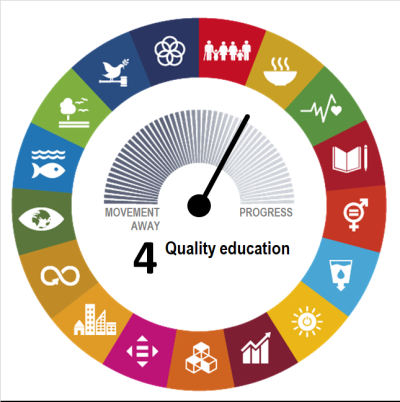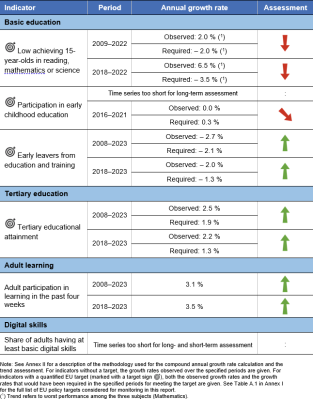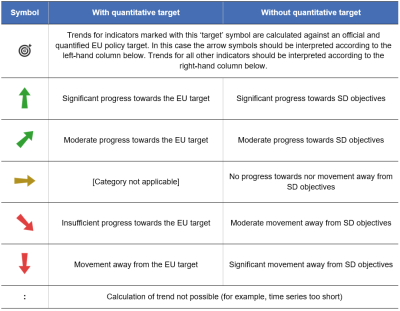Ensure inclusive and equitable quality education and promote lifelong learning opportunities for all
Data extracted in April 2024.
Planned article update: June 2025.
Highlights
This article is a part of a set of statistical articles, which are based on the Eurostat publication ’Sustainable development in the European Union — Monitoring report on progress towards the SDGs in an EU context — 2024 edition’. This report is the eighth edition of Eurostat’s series of monitoring reports on sustainable development, which provide a quantitative assessment of progress of the EU towards the SDGs in an EU context.
SDG 4 seeks to ensure access for all to quality education through all stages of life, as well as to increase the number of young people and adults who have the relevant skills for employment, decent jobs and entrepreneurship.
Quality education in the EU: overview and key trends
Education and training are key drivers for sustainable growth and democratic societies because they help to improve employability, productivity, innovation, competitiveness, health, equality, safety and civil involvement. In the broader sense, education is a pre-condition for achieving many SDGs. Monitoring SDG 4 in an EU context focuses on basic education, tertiary education, adult learning and digital skills. Over the assessed five-year period, the EU has made significant progress in increasing participation in basic and tertiary education as well as in adult learning and to a lesser extent in early childhood education. In contrast, trends in educational outcomes have been less favourable. The percentage of underachievers in the PISA test has further deteriorated, and the share of adults with at least basic digital skills remains far from its target.
Basic education
Basic education covers the earliest stages in a child’s educational pathway, ranging from early childhood education and care to primary and secondary education. An inclusive and quality education for all, which eliminates school segregation, is an essential element of sustainable development. SDG 4 thus aims to ensure that by 2030 all girls and boys have access to quality early childhood development, care and pre-primary education in order to be ready for primary education. In addition, SDG 4 intends to ensure that all boys and girls complete free, equitable and quality primary and secondary education leading to relevant and effective learning outcomes. Furthermore, SDG 4 focuses on ensuring that all youths have the literacy, numeracy and relevant skills needed for employment, decent jobs and entrepreneurship.
Participation in early childhood education and care deteriorated in 2021 and is not on track to meet the 2030 target
Early childhood education and care is usually the first step on a child’s educational pathway. According to the EU Quality Framework for Early Childhood Education and Care, access to quality early childhood education and care for all children contributes to their development, for example improved cognitive skills, educational success and by extension, future employment prospects. Also, as highlighted in the 2022 Council Recommendation on early childhood education and care, insufficient provision of early childhood education and care is a significant constraint on female labour market participation.
The 2021 Council Recommendation on a European child guarantee also emphasises the importance of equal access to quality and inclusive early childhood education and care for breaking the transmission of social exclusion and securing equal opportunities for children in a disadvantaged situation. Tackling disadvantage from early years is a cost-effective investment as it contributes to the inclusion of children, their school success and integration into the labour market and social life when they are adults. These positive effects are on average stronger among children from socioeconomically disadvantaged backgrounds, suggesting that early childhood education and care is a key factor in reducing inequality of opportunity. At the same time, children from these backgrounds are less likely to participate in early childhood education and care, particularly children under three years of age who are at risk of poverty or social exclusion, whose parents do not hold tertiary qualifications, and who live in large families [1].
Participation in early childhood education is defined as the share of the population aged between three years and the starting age of compulsory primary education who take part in early education. Participation in early childhood education has risen slowly in the EU since 2014, reaching 93.4 % in 2020. In 2021, the rate fell back to 92.5 %, which is only slightly above the level observed five years earlier (92.4 % in 2016). The EU is thus not on track towards meeting the target of 96 % by 2030.
Fewer young people in the EU drop out from education and training
According to the Council Recommendation on Pathways to School Success, school education can play a crucial role in promoting inclusive, fairer and more prosperous societies and economies. It thus aims to ensure better educational outcomes for all learners, by lifting the performance in basic skills and reducing early school leaving. Consequently, the EEA strategic framework has set a target to reduce the share of early leavers from education and training (ELET) to below 9 % by 2030.
Since 2002, the ELET rate has fallen continuously in the EU, albeit more slowly in recent years. In 2023 the share had reached 9.5 %, putting the EU well on track to meet the 2030 target. The reasons for early school leaving are complex and include both individual and socio-economic factors, as well as factors related to the education system itself [2]. An analysis by degree of urbanisation reveals that young people living in towns and suburbs (10.6 %) and rural areas (9.9 %) were more likely to leave school early than young people living in cities (8.6 %) in 2023 [3]. For further analyses of ELET trends by sex and citizenship, see the articles on SDG 5 ‘Gender equality’ and on SDG 10 ‘Reduced inequalities’. Monitoring of the 9 % target is complemented by a supplementary indicator on the completion of at least upper secondary education, which is generally considered the minimum requirement for gaining satisfactory employment in today’s economy and is important for full participation in society. The indicator, which measures the share of people aged 20 to 24 with at least an upper secondary qualification, shows that 84.1 % had completed this level of education in 2023 [4].
Educational outcomes have continued to deteriorate, most significantly in maths
Besides educational attainment in general, achieving a certain level of proficiency in basic skills is a key objective of all educational systems. Basic skills, such as reading a simple text or performing simple calculations, provide the foundations for learning, gaining specialised skills and personal development. Low achievers in the OECD's Programme for International Student Assessment (PISA) are those pupils who fail to reach the minimum proficiency level necessary to participate successfully in society. These pupils face having fewer opportunities in future, at both the personal and the professional level [5]. The personal socio-economic background is one of the key drivers behind educational underperformance and points to serious problems in terms of equality: the risk of underperformance for young people with a disadvantaged socio-economic background is almost six times higher than for those with an advantaged socio-economic background [6].
In 2022, more than one in every four 15-year-old pupils showed insufficient abilities in one or more of these basic skills. Test results in that year showed 29.5 % of pupils were low achievers for mathematics, followed by 26.2 % for reading and 24.2 % in science. Compared with 2018, these results are a significant step backward in all three domains, but most significantly in mathematics, with a decline of 6.6 percentage points. The results indicate that the EU is lagging seriously behind in all three domains when it comes to reaching the 2030 EU-level target of reducing the share of low-achieving 15-year-olds in basic skills to less than 15 %.
Tertiary education
Continuing education after the basic level is important in a knowledge-based economy because people with higher qualifications are more likely to be employed and less likely to face poverty. Therefore, investing efficiently and effectively in education and training systems that deliver high-quality and up-to-date services lays the foundation for a country’s prosperity. Moreover, employment rates are generally higher for highly educated people, who also enjoy better wages and working conditions. Conversely, low levels of tertiary educational attainment can hinder competitiveness, innovation and productivity and undermine growth potential.
The share of people with tertiary education has increased significantly since 2002
The EEA strategic framework aims to raise the share of the population aged 25 to 34 that has completed a higher education qualification (levels 5–8 in the 2011 International standard classification of education, ISCED) to at least 45 % by 2030. As a result of a 20.0 percentage point increase since 2002, the EU reached a tertiary education attainment rate of 43.1 % in 2023 and is well on track to meeting its 2030 target. The degree of urbanisation seems to be related to tertiary attainment levels. While in 2023 more than half (53.3 %) of the population aged 25 to 34 living in cities had attained tertiary education, the rate was significantly lower for towns and suburbs (36.7 %) and rural areas (31.7 %) [7].
The share of 25- to 34-year-olds with tertiary education has been growing steadily since 2002 in all Member States. This partly reflects their investment in higher education to meet the demand for a more skilled labour force. Moreover, some countries shifted to shorter degree programmes following the implementation of the Bologna process reforms. For further analyses of the trends in tertiary education by sex, see the articles on SDG 5 ‘Gender equality’ and on SDG 9 ‘Industry, innovation and infrastructure’.
Adult learning
Keeping skills up to date to support the ongoing quest for a high-quality labour force is one of the goals of adult learning. Adult education covers the longest period in a person’s learning lifetime. It helps to improve and develop skills, adapt to technological developments, advance a person’s career or aid their return to the labour market (upskilling and reskilling). Moreover, it is crucial for maintaining good health, remaining active in the community and being fully included in all aspects of society.
Adult participation in learning is growing
Adult participation in learning monitors the share of people aged 25 to 64 who stated they received formal or non-formal education and training in the four weeks preceding the survey. This share has grown almost steadily since 2002, when it stood at 5.3 %, reaching 12.7 % in 2023. A temporary drop was observed in 2020, which might be related to the COVID-19 pandemic and the adjustments to the related contingency measures, such as lay-offs and teleworking. Similarly, for adults not in employment, enrolment in education and training programmes reduced temporarily during the beginning of the pandemic due to extended lockdown periods. Since 2020, however, the share of adults participating in learning has grown strongly, gaining 3.6 percentage points until 2023.
Women are more likely to participate in adult learning than men. In 2023, the share of 25- to 64-year-old women was 2.4 percentage points higher than that for men (13.9 % compared with 11.5 %, respectively). The rate for women was not only higher than for men, it had also been improving faster, gaining 8.4 percentage points between 2002 and 2023, compared with 6.5 percentage points for men. The participation rate in adult learning also differs in terms of degree of urbanisation. In 2023, adults living in cities were more likely to participate in learning (15.7 %) than those living in towns and suburbs (11.3 %) or rural areas (9.7 %) [8].
While the above-mentioned indicator is based on the question of whether adults participated in learning during the four weeks preceding the survey, the target defined in the EEA strategic framework and the European Pillar of Social Rights Action Plan refers to the share of adults participating in learning during the past 12 months. Data for this target definition are currently collected every six years through the Adult Education Survey (AES). The most recent data are from 2022 and show that the share of adults participating in learning during the past 12 months stood at 39.5 %, which is 7.5 percentage points below the EU target of 47 % for 2025 and 20.5 percentage points below the 2030 target of 60 %. Participation rates were particularly low for low-educated adults (ISCED 2011 levels 0–2), at 18.4 %. In contrast to this group, 58.9 % of adults with tertiary education (ISCED 2011 levels 5–8) participated in learning in 2022 [9].
Digital skills
Digitalisation is having a massive impact on the labour market and the type of skills needed in the economy and society. Thus, digital skills are of critical value for working, learning and social interaction. During the COVID-19 pandemic, the digital skills gap became more pronounced while new inequalities emerged: many people still do not possess basic level of digital skills, are in workplaces or schools that are lagging behind in digitalisation or have limited access to digital tools and infrastructures.
The share of people with at least basic digital skills remains far from the 2030 target
The European Pillar of Social Rights Action Plan has set a complementary target for the EU to raise the share of people aged 16 to 74 who have at least basic digital skills to 80 % in 2030. This target is monitored using the composite indicator for digital skills, based on selected activities performed by individuals on the internet in specific areas: information and data literacy, communication and collaboration, digital content creation, safety and problem solving. The level of ‘at least basic digital skills’ refers to the two highest out of six levels derived from the survey on the use of information and communication technologies (ICT) in households and by individuals. It is assumed that individuals who can perform certain activities have the desired digital skills, therefore the indicator can be considered as a proxy for the digital competences and skills of individuals. In 2023, the share of people aged 16 to 74 with at least basic digital skills stood at 55.6 %. While this share is 1.7 percentage points higher than in 2021, when it was 53.9 %, it remained at a level considerably below the 80 % target for 2030. In contrast to most other education indicators presented in this chapter, overall fewer women (54.5 % in 2023) had at least basic digital skills than men (56.7 %). However, the gap between women and men varies strongly across different age groups. In the age group under 45 years, more women than men had at least basic digital skills. The situation starts to reverse in the age group above 45 years, where men are more likely to have at least basic digital skills than women. In general, age and formal education also affect a person’s level of digital skills. While 70.0 % of 16- to 24-year-olds had basic or above-basic digital skills in 2023, this was only the case for 64.0 % of 25- to 54-year-olds. Older people struggle in particular with the use of digital media, with only 37.1 % of people aged 55 to 74 having at least basic digital skills in 2023. Additionally, 79.8 % of people with high formal education had such digital skills in 2023, while this was only the case for 33.6 % of people with no or low formal education [10].
Digital competences constitute an essential skill for participating in a technology-driven world. In the EEA strategic framework, the EU sets a target for the share of low-achieving eighth-graders in computer and information literacy to be less than 15 % by 2030. One of the key findings of the International Computer and Information Literacy Study (ICILS) carried out in 2018 shows that young people do not develop sophisticated digital skills just by growing up using digital devices: in 8 out of 13 Member States participating in the study, more than one-third of pupils achieved scores below level 2 on the ICILS CIL scale. This level can be defined as the threshold for underachievement in digital competence [11].
Main indicators
Low achieving 15-year-olds in reading, mathematics or science
This indicator measures the share of 15-year-old students failing to reach level 2 (‘basic skills level’) on the Programme for International Student Assessment (PISA) scale for the three core school subjects of reading, mathematics and science. The data stem from the PISA study, a triennial international survey that aims to evaluate education systems by testing the skills and knowledge of 15-year-old students.
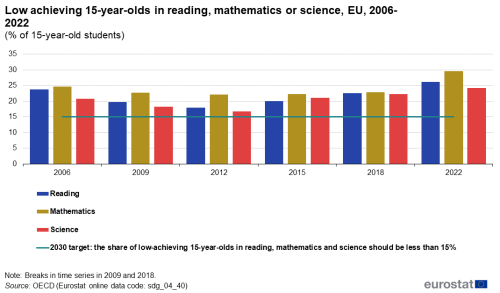
Source: OECD (Eurostat online data code (sdg_04_40))
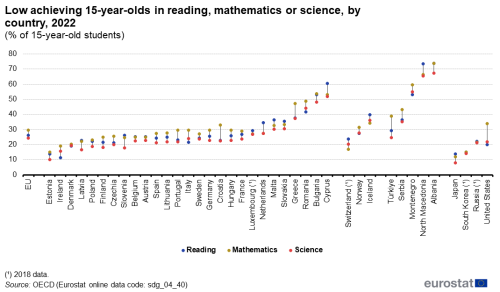
Source: OECD (Eurostat online data code (sdg_04_40))
Participation in early childhood education
This indicator measures the share of children between the age of three and the starting age of compulsory primary education who participated in early childhood education. Data presented here stem from the joint UIS (UNESCO Institute of Statistics)/OECD/Eurostat (UOE) questionnaires on education statistics, which constitute the core database on education.
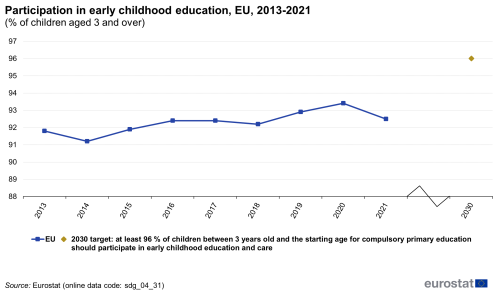
Note: y-axis does not start at 0.
Source: Eurostat (sdg_04_31)
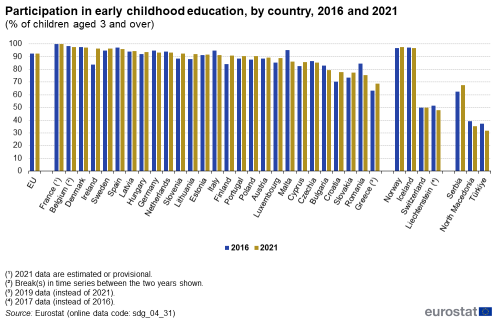
Source: Eurostat (sdg_04_31)
Early leavers from education and training
The indicator measures the share of the population aged 18 to 24 with at most lower secondary education who were not involved in any education or training during the four weeks preceding the survey. The data stem from the EU Labour Force Survey (EU-LFS).

Note: y-axis does not start at 0.
Source: Eurostat (sdg_04_10)
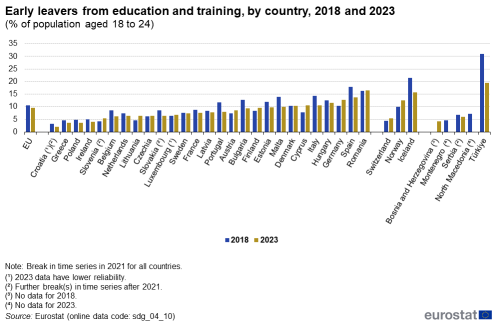
Source: Eurostat (sdg_04_10)
Tertiary educational attainment
This indicator measures the share of the population aged 25 to 34 who have successfully completed tertiary studies (for example, at university or a higher technical institution). Tertiary educational attainment refers to ISCED (International Standard Classification of Education) 2011 levels 5–8 for data from 2014 onwards and to ISCED 1997 levels 5–6 for data up to 2013. The indicator is based on the EU Labour Force Survey (EU-LFS).

Note: y-axis does not start at 0.
Source: Eurostat (sdg_04_20)
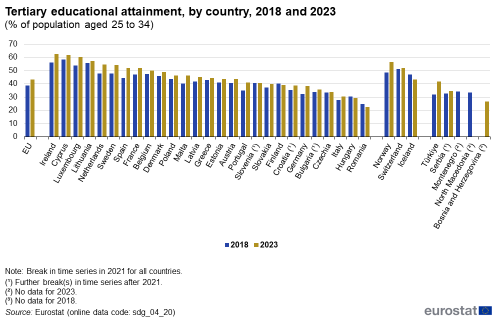
Source: Eurostat (sdg_04_20)

Source: Eurostat (edat_lfse_04)
Adult participation in learning in the past four weeks
Adult participation in learning refers to people aged 25 to 64 who stated they received formal or non-formal education and training in the four weeks preceding the survey (numerator). The denominator consists of the total population of the same age group, excluding those who did not answer the question ‘participation in education and training’. Adult learning covers formal and non-formal learning activities — both general and vocational — undertaken by those aged 25–64 [12]. Data stem from the EU Labour Force Survey (EU-LFS).
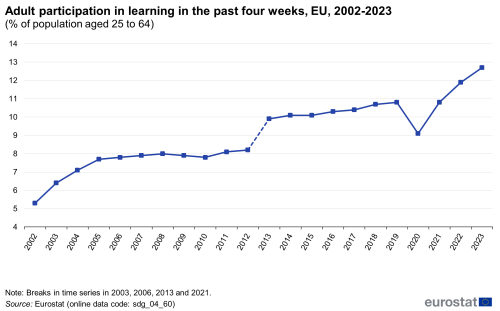
Note: y-axis does not start at 0.
Source: Eurostat (sdg_04_60)
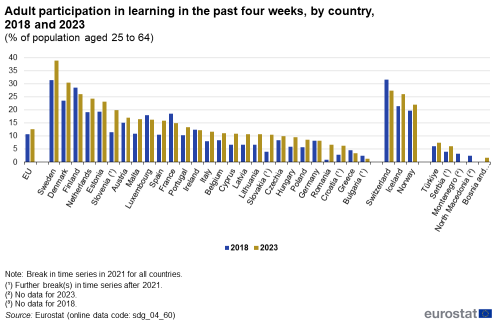
Source: Eurostat (sdg_04_60)
This indicator measures the share of people aged 16 to 74 who have at least basic digital skills. It is a composite indicator based on selected activities performed by individuals on the internet in specific areas: information and data literacy, communication and collaboration, digital content creation, safety and problem solving. The indicator assesses digital skills classified into six levels, of which the two highest constitute the basic or above basic level of digital skills. The indicator is based on data from the EU survey on the use of ICT in households and by individuals.
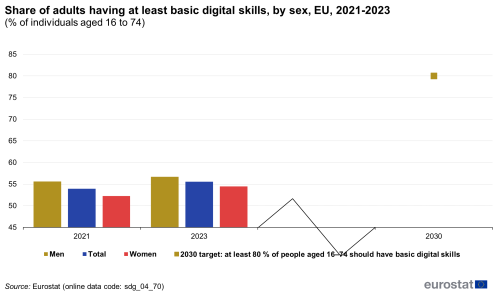
Note: y-axis does not start at 0.
Source: Eurostat (sdg_04_70)
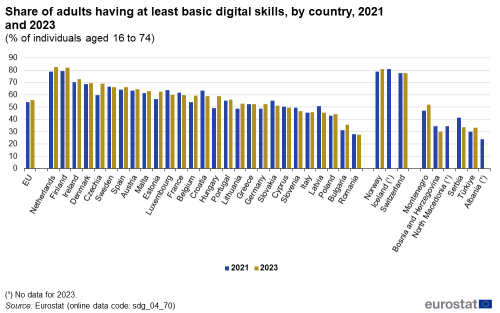
Source: Eurostat (sdg_04_70)
Notes
- ↑ For more information see: European Commission (2022), and Social Developments in Europe, Publications Office of the European Union, Luxembourg, p. 118.
- ↑ There are many reasons why some young people give up education and training prematurely: personal or family problems, learning difficulties, or a fragile socio-economic situation. The way the education system is set up, school climate and teacher-pupil relations are also important factors. Since there are often complex, interconnected reasons for children not completing secondary schooling, policies to reduce early school leaving must address a range of issues and combine education and social policy, youth work and health-related aspects. For more information, see: European Commission, European Education Area, Early school leaving.
- ↑ Source: Eurostat (online data code: (edat_lfse_30)).
- ↑ Source: Eurostat (online data code: (yth_educ_030)).
- ↑ European Commission (2019), PISA 2018 and the EU. Striving for social fairness through education, p. 7.
- ↑ Data confirm that one of the key drivers behind educational underperformance is a person’s socio-economic background. For more information, especially on the new EU-level indicator for equity in education, see: European Commission (2022), Progress towards the achievement of the European Education Area, Publications Office of the European Union, Luxembourg, pp. 24–25.
- ↑ Source: Eurostat (online data code: (edat_lfs_9913)).
- ↑ Source: Eurostat (online data code: (trng_lfs_14)).
- ↑ Source: Eurostat (Adult Education Survey, special calculation excluding guided on-the-job training as available in the public excel file).
- ↑ Source: Eurostat (online data code: (ISOC_SK_DSKL_I21)).
- ↑ For more information see: European Commission (2022), Education and Training Monitor 2022 (europa.eu)
- ↑ The general definition of adult learning covers formal, non-formal and informal training but the indicator adult participation in learning only covers formal and non-formal education and training. For more information, see: Eurostat, Participation in education and training.
Explore further
Other articles
Database
Thematic section
Publications
Further reading on quality education
- European Commission (2023), Education and Training Monitor 2023, Publications Office of the European Union, Luxembourg.
- European Commission (2019), PISA 2018 and the EU. Striving for social fairness through education, Publications Office of the European Union, Luxembourg.
- OECD (2019), Skills Matter: Skills Matter: Additional Results from the Survey of Adult Skills, OECD Skills Studies, OECD Publishing, Paris.
- OECD (2023), Education at a Glance 2023: OECD Indicators, OECD Publishing, Paris.
- UNESCO (2018), Handbook on Measuring Equity in Education, Montreal.
Methodology
More detailed information on EU SDG indicators for monitoring of progress towards the UN Sustainable Development Goals (SDGs), such as indicator relevance, definitions, methodological notes, background and potential linkages can be found in the introduction as well as in Annex II of the publication ’Sustainable development in the European Union — Monitoring report on progress towards the SDGs in an EU context — 2024 edition’.
External links
Further data sources on quality education

